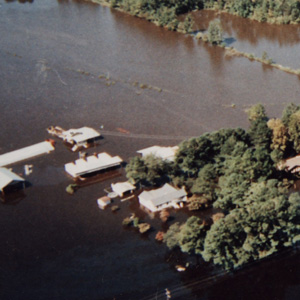
East Carolina has weathered a number of hurricanes, but few have caused as much damage as Hazel in 1954 and Floyd in 1999. Of the two, Floyd brought not only fallen trees, flooded homes, and power losses, but most tragically, the death of an ECU student, Aaron Christopher Child (1981-1999). From Floyd forward, ECU has responded with an abundance of caution in an effort to ensure that human life would never again be lost to a hurricane.
Hazel first formed as a tropical storm near the Lesser Antilles, then wreaked havoc in Haiti before moving north through the Bahamas and making landfall on October 15 near the North Carolina-South Carolina border. At landfall, it was a Category 4 hurricane with sustained winds of 130 mph.
Hazel’s arrival Homecoming weekend was largely unexpected by the student body. The student newspaper, the East Carolinian, made no mention of it on the day of landfall. Meteorologists had predicted that Hazel would turn east, avoiding the coast, but such predictions proved mistaken. Classes at ECC were finally cancelled as winds approached 80 mph. Students planning to leave town were ordered to take shelter in their dormitories. Wright Building was hastily converted into a community shelter. The entire campus soon lost power as strong winds toppled utility poles throughout town. Fortunately, Hazel moved rapidly with a ground speed of nearly 30 mph. Just twelve hours after landfall, it had traveled northward to Pennsylvania.
Hazel did no major damage to the campus. Several roads were blocked by downed trees, and many buildings lost windows to flying debris. Old Austin lost some of its roof. Greenville’s tobacco warehouses, however, suffered greatly, with two losing their roofs. Fifteen airplanes in the Pitt-Greenville Airport hangars were also damaged. Yet Pitt County fared well compared to other places. Landfall occurred during the highest lunar tide of the year, causing storm surge exceeding fifteen feet from Southport to Topsail Beach in southeastern North Carolina. Nineteen lives were lost. Resulting property damage was estimated at $163 million in the Carolinas alone. Surprisingly, however, Hazel did its greatest damage in Toronto, Canada. The storm stalled there, causing torrential flooding that left 80 people dead.
East Carolina’s worst experience came in 1999, with Floyd. After crossing the Atlantic, Floyd struck the Bahamas as a Category 5 hurricane before weakening to a Category 2 at landfall near Cape Fear on September 16. Still, its winds lashed the Carolinas at speeds in excess of 100 m.p.h. Its enormous one thousand-mile diameter brought torrential rains and severe flooding. Worsening matters, Floyd arrived on the heels of Hurricane Dennis, which had already inundated eastern North Carolina in early September. Saturated ground and flooded waterways were overwhelmed by Floyd’s downpour. Greenville received 12.86 inches from Floyd alone during what was the wettest September on record.
ECU sustained severe damage as the Green Mill Run and Tar River were overwhelmed with runoff in the weeks after Floyd. The lower floors of the General Classroom Building (now Bate) and Howell Science Building flooded as the old Arboretum Lake bed refilled where the Science and Technology Building now stands. Floyd ultimately caused over four million dollars of damage to the campus. Approximately five thousand students were displaced by the floodwaters as apartment complexes close to the Tar River ended up submerged. Tragically, an ECU student was among the state’s 52 storm-related deaths. Aaron Christopher Child, an 18-year-old freshman, was found dead at the bottom of College Hill six days after going missing from his Greenville apartment. Child had been returning to this dorm from his brother’s off-campus apartment when he drowned in the floodwaters of the creek below College Hill.
Chancellor Richard Eakin led the campus in mourning Child. His message was clear: “We are all, each one of us, forever touched by this storm. But we know what it takes to overcome tragedy and become a success. We count on you to make it happen!” The school calendar was promptly altered to ease the burdens on students and mitigate withdrawals expected as a result of the crisis. On September 25, the Pirates competed against football rivals the Miami Hurricanes in NC State’s Carter-Finley Stadium. The game had been relocated because Greenville was in no condition to host it. After trailing the nationally-ranked team 23-3 at halftime, the Pirates stormed back to defeat the Hurricanes 27-23. Pirate fans brought down the goalposts at Carter-Finley Stadium in celebration, a costly display of excess for a school already facing serious financial obligations resulting from Floyd. Still, the come-from-behind victory made manifest eastern North Carolina’s resilient determination in the face of catastrophe, and its undaunted resolve to emerge victorious over the Hurricanes.
Sources
- "A Message from the Chancellor," East Carolinian Vol. 74, Special Hurricane Recovery Edition, September 28, 1999.
- Banks, Margaret Moffett. "Body of ECU Student Found Near Campus." Greensboro News and Record. September 22, 1999. https://www.greensboro.com/body-of-ecu-student-found-near-campus-missing-freshman-s/article_9bc770e2-7d3a-5b21-a2ce-21c88d2f6a9d.html.
- Barnes, Jay. North Carolina's Hurricane History. Chapel Hill, NC: The University of North Carolina Press, 2013.
- "ECU students turn down trailer offer: Campus still reeling in wake of Floyd." Asheville Citizen-Times. October 28, 1999. P. 14.
- Harris, Holly. "Damage to University Totals More Than $4 Million," East Carolinian Vol. 74, No. 64, September 30, 1999.
- "Hurricane, Flooding Devastates Area," East Carolinian Vol. 74, Special Hurricane Recovery Edition, September 28, 1999.
- "Hurricane Floyd Symposium, September 17-18, 2009." http://www.ecu.edu/renci/floyd/.
- "Hurricane Hazel Strikes, Plays Havoc with Campus," East Carolinian Vol. 30, No. 6, October 22, 1954.
- "Hurricane Moves on N. C. Capes," Daily Reflector, October 14, 1954.
- Pressley, Sue Anne. "Floyd Rains Pain on Family, N.C. Campus." Washington Post. September 30, 1999. https://www.washingtonpost.com/archive/politics/1999/09/30/floyd-rains-pain-on-family-nc-campus/4b144fc6-ba56-4b27-8243-d14f30e6be51/?utm_term=.58da3ad6af3e.
- "Storm Precautions Taken," Daily Reflector, October 15, 1954.
- "Storms to Life." https://www.ecu.edu/renci/StormsToLife/about.html.
- "Ten Years After the Flood: Hurricane Floyd and Its Aftermath." http://www.piratealumni.com/s/722/hybrid/index.aspx?pgid=765&gid=1&cid=5462.
- "Warehouse is Hardest Hit," Daily Reflector, October 16, 1954.
Additional Related Material








Citation Information
Title: ECU's Hurricane History
Author: John A. Tucker, PhD
Date of Publication: 7/18/2019